
Sky Yoga (Aerial Yoga)
Sky Yoga is a relatively new contemporary yoga style that uses traditional poses performed with the aid of a fabric sling or hammock.
Sky Yoga is also known as aerial yoga it is inspired by the vinyasa style of yoga, Pilates, Calisthenics, aerial acrobatics and is said to use poses that flow in an original sequence. By using a fabric sling or hammock and being off the ground, it will help you to heighten your attention to balance and stability.
Most sky yoga classes consist of deep stretching, relaxation, floor and aerial asana. By having your body suspended above the ground, your body weight gets distributed between the ground and the ceiling this allows for multiple possible variations of strength-building, flexibility, and core strengthening poses.
While many people viewed sky yoga as a fad, it is continuing to gain momentum and a loyal following. Sky Yoga is now over a decade old and has training studios dedicated strictly to this form of yoga.
The hammocks used at most of these studios are made from a high-density nylon material and are designed to support between 1000 lbs and 2000 lbs depending on the type used so even overweight people can feel comfortable hanging in them without a fear of the fabric giving way.
The hammock allows someone to either deepen the stretch or lighten the stretch by using gravity and minor alterations in his or her positioning. Small changes in position while you get suspended off of the floor will allow the exercises to act as a de-stabilizer, add resistance and challenge or assist in your balance.
Using a sling also allows you to try different poses that you would not be able to do on the ground helping to aid with muscle memory and confidence before attempting the pose without the sling.
Many of the basic poses are simple stretches done while you sit on a hammock. As you progress, you will move on to poses that involve hanging upside down and grabbing your thighs, ankles or feet to help provide support and balance.
Classes are available for all levels of fitness with minor alterations offered to cater to a person's capabilities. However, like all training routines look around to find a knowledgeable trainer who makes you feel comfortable while performing the poses.
Common Sky / Aerial Yoga Poses And Proposed Benefits
Layback Cross Position Pose
- Provides a stretch to your chest, shoulders, lungs, and abdomen.
- Said to Stimulate the nervous system (no scientific backing as of yet).
- Can help to improve posture.
- Can contribute to relieving stress.
- Said to be Therapeutic for asthma (no scientific backing as of yet).

Aerial Lunges
- Stretches your quads and hip flexors.
-
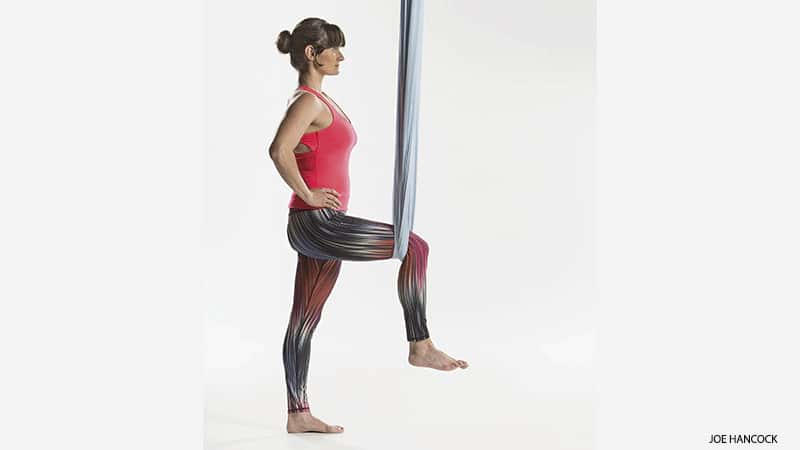
Cross In Chair Position
- Decompression of the Spine.
- Can help to reduce lower back suffering and pain caused by sciatica.
- Can improve your posture.
-
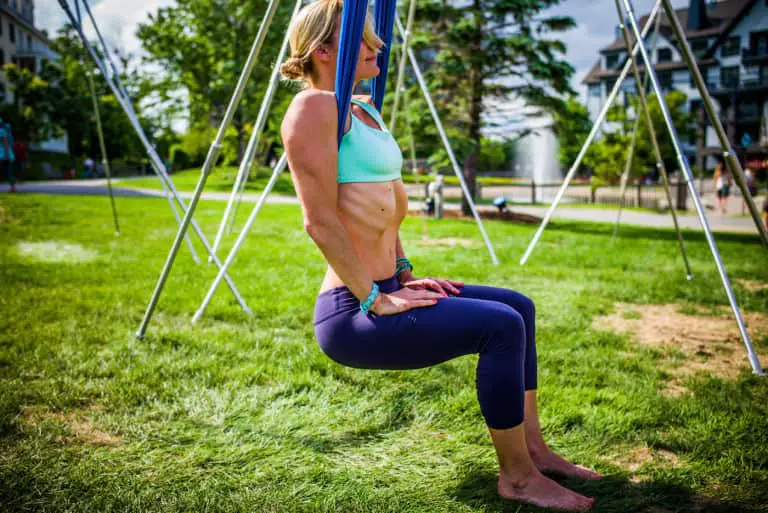
Wrist Wrap Shoulder Strech
- Provides a stretch to your shoulder and spine.
- Can help to Improve posture.
- Can contribute to reducing lower back pain and pain caused by sciatica.
-
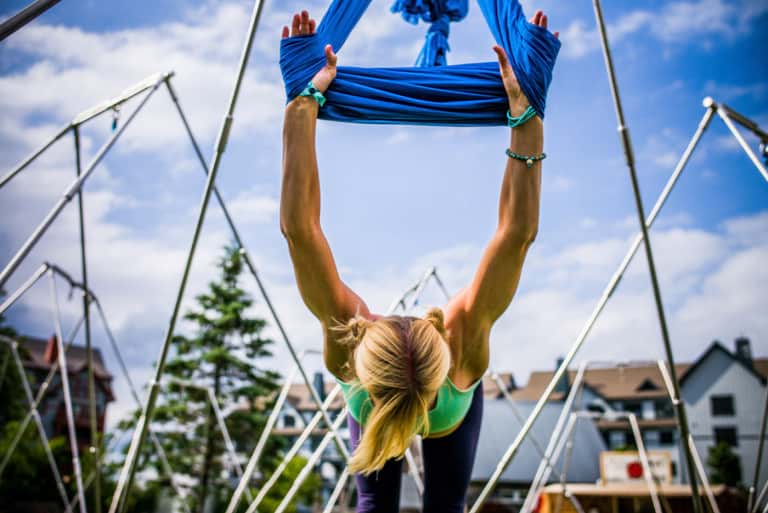
Feet In Hammock Plank
- Helps to Strengthen and tone your core, legs shoulders, wrists and your arms. When you engage your glutes, it can provide mild relief for lower back pain.
- Improves your posture.
- Increases your balance and stability.
-
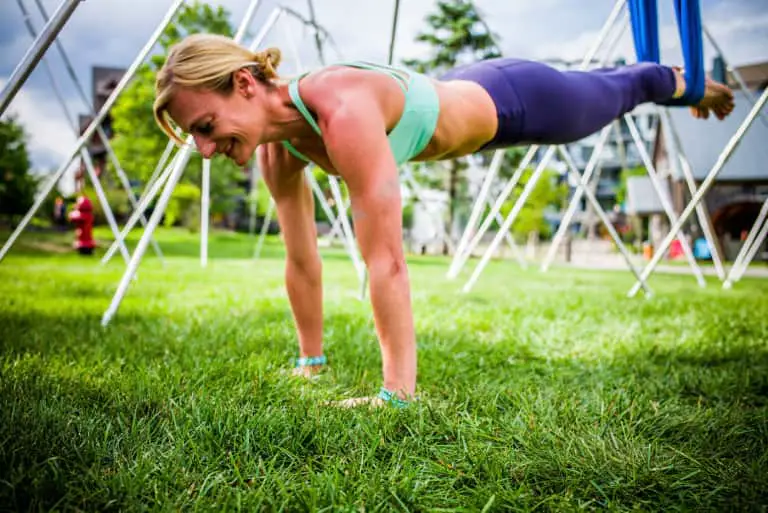
Hammock Pike And Pull
- Provides a stretch to the hamstrings, thighs, and hips.
- Can help to reduce sciatica and lower back pain.
- Improves balance and focus.
- Improves digestion (no scientific backing as of yet).
-
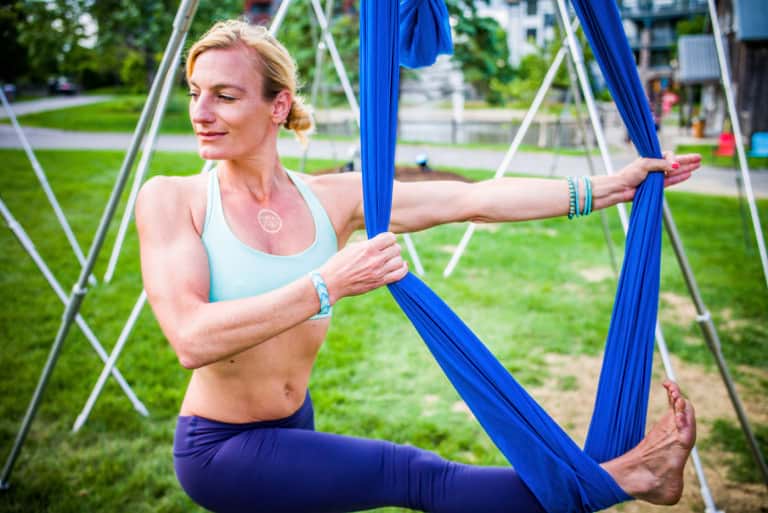
Star Inversion
- Helps your spine to Decompress.
- Contributes to relieving stress, anxiety, insomnia(no scientific backing as of yet), and mild depression.
- Calms the mind, allowing you to think more clearly.
- Increases circulation and decreases inflammation (no scientific support as of yet).
- Regulates temperature (no scientific backing as of yet).
- Allows gravity to naturally align the spine.
- Relieves menstrual cramps and menopause symptoms(no scientific support as of yet).
-

Floating Savasana
- Calms the brain, relaxes the body and mind.
- Having your body wrapped in silk can help you feel secure and safe.
- Ease of sinking and melting into a deeply relaxed state.
-
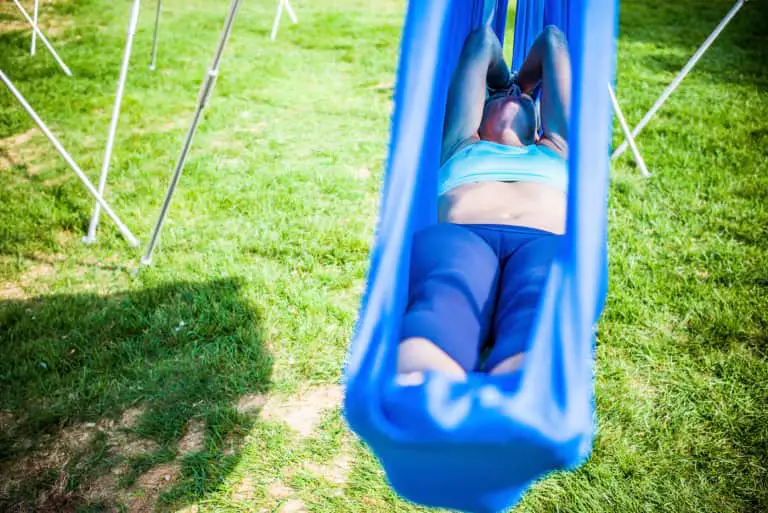
108 Sky/Aerial Yoga Poses Possible With Omi Gym

The Benefits of Sky / Aerial Yoga
- Many poses that would result in a high degree of cervical spine compression like the headstand to not place as great of a strain on your body due to being inverted.
- It is extremely helpful for reducing lower back pain for many people.
- Shown to help increase pushing and pulling power contribute to developing your upper body strength.
- When working on a routine with backward bending compression of your vertebral discs is decreased.
- Your core gets activated to a higher degree because of the hammock requiring greater activation of your core muscles to maintain balance.
- The sling also allows people to hold their inversion exercises longer because of the reduced stress on their body.
- By being in a sling, a person's poor alignment habits are more noticeable compared to regular yoga.
- The sling is also shown to help the yoga instructor to assess and identify posturally and muscle imbalances easier.
- There is anecdotal evidence indicating that aerial yoga facilitates bending and stretching of the whole body shown to help improve joint and muscle strength.
- Proved to help with decompressing of a person's spine.
- Increases blood circulation improving circulatory, respiratory and digestive systems.
- It is a total body workout and is showing to be a useful tool for people currently involved in physical rehabilitation.
- Classes are also available for children, and many may be much more interested in performing these exercises since being suspended in mid air seems interesting and cool (at least that is what I have found with my daughters).
Who Is Sky Yoga Not For
Tips & Safety
As with beginning any new training routine, you should first be checked by a physician to understand any limitations that may interfere or cause harm by performing this new training program.
- Pregnant women – The flips and inversions involved with aerial yoga has shown to be stressful for the body of pregnant women.
- People who have had a recent eye surgery - If your eyes have not fully healed yet sky yoga can cause further injury to the eyes.
- Sufferers of vertigo - Sudden changes in the movement has shown to trigger vertigo attacks.
- Cardiovascular diseases
- Bone disorders
- High/Low blood pressure
- Prosthetic hips
- Colds/Flu/Any condition that blocks the nasal passages
Sky / Air Yoga is heavily rooted from the traditional yogic discipline. The practice of sky / Aerial Yoga is meant to complement, not replace, any regular yoga practices.
If you do decide to give sky yoga a try here are some basic tips to help you avoid injuring yourself in the first class.
Tips & Safety
- Clothes should be form fitting. Loose and or baggy clothes are known to make it more difficult for you to move in and also carry a higher chance of getting caught within the hammock's mechanisms.
- Perform the routine in bare feet. Most people find it easier and more comfortable to move around the hammock.
- Drink plenty of water and have a light meal one to two hours before the class.
- Try to avoid acidic liquid and soft drinks before the class since many find it upsetting to their stomach while they are performing upside down movements.
- Do not use any lotions since it will either cause your hands to stick or slip from the material of the hammock.
- All of your jewelry, watches or anything that can rip into or get tangled into the hammock should be removed.
- DONT DO IT ALONE. If you are 100% confident in your aerial yoga skills for example being a professional gymnast, the exercises will be easy for you to grasp and perform but if you are not it is a lot safer doing these poses with other people around to help and guide you.
Looking to gain more strength or lose some weight? We offer free fitness tools to help you reach your fitness goals. Register for free while we are in beta and get free lifetime access to our fitness tools that include an easy to use Calorie Counter, High-Intensity Interval Timer, Multiple Fitness Calculators and our Exercise Logger.